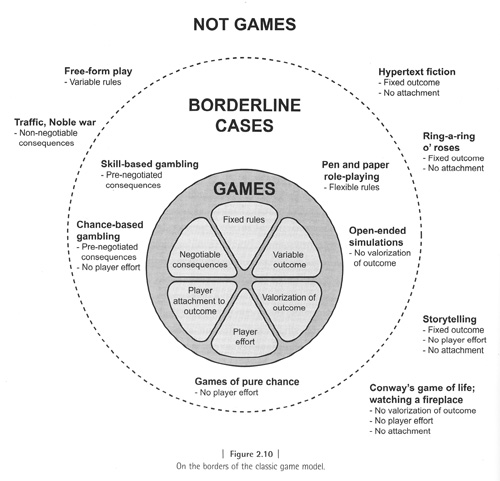Jesper Juul: Half-Real
Juul’s thesis is that games are a combination of real rules with fictional context. His primary focus of study is videogames specifically. As a self described ludologist, Juul is primarily concerned with the aesthetics of rule based systems on their own, and the larger acceptance of free standing game studies as a viable academic discipline. The first prerogative in this agenda is to define games as the field of study. Juul defines games with the following bullet points (p. 7):
- A game is a rule based system.
- It has variable and quantifiable outcomes.
- Different outcomes are assigned different values.
- The player exerts effort in order to influence the outcome.
- The player feels emotionally attached to the outcome.
- The consequences of the activity are optional and negotiable.
This set of six qualifiers characterizes the medium, the compositional substance of games. Juul’s perception is simultaneously broad, but also narrow. The focus is to distinguish that which separates games from non-games. The chief element of this definition is on the outcome of the game, but various “game-like” activities have ambiguous outcomes. A chief example of this is with role-playing games. There is a large collection of borderline cases which are discussed later.
One of the central elements in Juul’s book is the conflict between rules and fiction. Juul poses the argument, which he immediately refutes, that fiction is unimportant because it is incidental to a game. This reverberates with the larger ludology/narratology conflict. One issue I that seems to be missed here is that rules themselves have procedural, and therefore representational elements. If cognitive science has taught us anything, it is that the human mind does not work using abstract symbols, but rather association. Rules and causality may be associative like anything else. This argument does not put forward the idea that meaning in games is narrative in nature, though.
Juul explains the paradoxical nature of rules, play, and fun. Games are somewhat self contradictory because of their reliance on free form play and concrete rules. The restriction created by rules brings meaning to the actions and outcomes in the game world. “The rules of a game add meaning and enable actions by setting up differences between potential moves and events.” (p. 19) This distinction is very relevant in comparison to role-playing games, which use the rules themselves to make the world more credible. Rules legitimize actions, bestowing meaning upon play, which would otherwise just be chaos.
There is a conflicted relationship between games and art. This has to do with the role of emotions within games. “Video games generally focus on manipulating and moving objects, and less commonly address the more complex interactions between humans such as friendships, love, and deceit. We can suggest many reasons why this is so–we can blame unimaginative game designers; we can blame a conservative game audience; we can blame a ris-dverse game industry; and finally we can look at game design and see that the game form lends itself more easily to some things than to others–it is hard to create a game about emotions because emotions are hard to implement in rules.” (p. 20)
I would actually posit a slightly different argument. Juul is saying that emotions are hard to implement as rules, which suggests that emotions could be unambiguously modeled. This suggests that emotional states would be manipulated like any other token in the game mechanics. I would argue instead that it is hard for emotion to clearly emerge from rules. The formulas for a love story or a horror movie are not without structure. Given structure alone, players cannot get emotion, because emotion arises from human experience. What is required instead is for rules to be represented in a way that reflects human experience. Games do reflect human experience and they do generate emotion, but the range of emotions that they reliably represent and evoke (anger, fear, joy) is only a small sliver of the human emotional spectrum.
Video Games and the Classic Game Model
Juul is interested in defining a model of games. The reason for this is that a model can be tested. Once laid out, it is a discursive object. A model can be used to identify boundaries and borderline cases. A model is also a productive set. Given a model of games, one can attempt create games that push the boundaries of that model in interesting ways.
The six features of games as described earlier are to be seen as necessities. Juul argues that they should fall along the lines of conditions that are necessary and sufficient, as opposed to dimensions of games. Things such as The Sims and tabletop roleplaying are borderline cases. An example of the game spectrum can be seen on (p. 44)
On transmediation of games: Adaptations must accomodate rules and state. Only discussed here are games falling within the frame of the classic model. This makes sense for examples such as the equivalence of a particular number game with tic-tac-toe, but is not really viable for adaptations that involve setting. Adaptations in role-playing games are ample enough for a full study on their own. For example, D&D referencing Lord of the Rings, also various board and card games, and of course, RPG game settings. Neglected also in the discussion is experience. The experience of playing the number game is dramatically different from the experience of playing tic-tac-toe.
| Author/Editor | Juul, Jesper |
| Title | Half Real |
| Type | book |
| Context | |
| Tags | specials, digital media, games |
| Lookup | Google Scholar, Google Books, Amazon |


